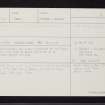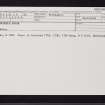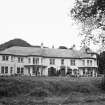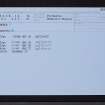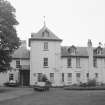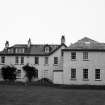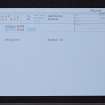Dunkeld, Dunkeld House
Country House (20th Century), Hotel (20th Century)
Site Name Dunkeld, Dunkeld House
Classification Country House (20th Century), Hotel (20th Century)
Alternative Name(s) Dunkeld House Policies; Garden Features; Dunkeld House Hotel
Canmore ID 27169
Site Number NO04SW 16
NGR NO 01096 42598
Datum OSGB36 - NGR
Permalink http://canmore.org.uk/site/27169
- Council Perth And Kinross
- Parish Dunkeld And Dowally
- Former Region Tayside
- Former District Perth And Kinross
- Former County Perthshire
NO04SW 16.00 01081 42596
NO04SW 16.01 NO 02589 42765 Ice House
NO04SW 16.02 NO 02579 42925 Dunkeld Lodge and Gate (Atholl Park Lodge and Langlea Lodge)
NO04SW 16.03 NO 02298 43129 Gazebo
NO04SW 16.04 NO 0233 4308 Hot Houses (Walled Garden)
NO04SW 16.05 NO 00794 42680 West Grotto
NO04SW 16.06 NO 0260 4285 Stables
NO04SW 16.07 NO 02218 43227 Gallowhill Lodge and Gate
NO04SW 16.08 NO 0205 4297 Kennels
NO04SW 16.09 NO 0136 4306 Pulney Lodge and Gate
NO04SW 16.10 Centred NO 02300 43063 Terraced walled garden
NO04SW 16.11 NO 02050 42448 East Grotto
NO04SW 16.12 Centred NO 0149 4255 Terraces ('Giant's Steps' - terraced garden)
NO04SW 16.13 NO 0150 4262 Ornamental Fort ('Prospect Tower' - folly)
NO04SW 16.14 Centred NO 0210 4283 Stone-lined Pits
See also:
NO04SW 29 NO 02039 42640 Dunkeld, Bishop's Hill, New Palace
For Pictish symbol stone formerly in the grounds of Dunkeld House (at NO 0104 4273) and now in Dunkeld Cathedral, see NO04SW 1.02.
Dunkeld House, the former residence of the Dukes of Atholl, was taken by storm and blown up by Commonwealth troops in 1653.
(Undated) information in NMRS.
Dunkeld House, built by Wm Bruce 1679, demolished early 19thc, but row of stables, etc. behind house survived until after 1858.
OS 6" map, Perthshire (1858)
Original 17th century house to North of cathedral, demolished early 19th century. Dunkeld New Palace to West of cathedral begun 1820, discontinued 1830 due to death of Duke of Atholl and demolished. Dunkeld House Hotel built as house for Duke and Duchess of Atholl 1900, now hotel.
OWNER: Duke of Atholl
ARCHITECT: Sir William Bruce late17th century old house
James Winter 1744 design for house and offices
Roger Morris 1753 Chinese temple
Robert Adam 1765 designs for gateways
George Steuart 1777 conservatory and design for a bath
Archibald Elliot 1809 gateway and stables
Thomas Hopper c.1820 New Palace or House
Robert Dickson 1853 kennels and stables
J Macintyre Henry 1898 new house
NMRS REFERENCE
Plans:
I G Lindsay Collection, W/234 Uncertain if relating to Dunkeld House, New Palace or House Hotel.
EXTERNAL REFERENCE
National Library Nattes Drawings Vol.2 nos 7/9
National Archive Of Scotland Chronicles of Tullibardine 1908 Vol.4
Note (April 1989)
Dunkeld House, the former residence of the Duke of Atholl, stood to the N of the cathedral (NO04SW 1.00). It was destroyed by Commonwealth troops in 1653 but was rebuilt in 1679; the house was eventually demolished in the early 19th century, although the stable block and court of offices remained until after 1858. The house of 1679, designed by William Bruce, is depicted by Slezer.
Cropmarks confirm the extent of the ancillary buildings and the layout of the policies as revealed on a plan of the lawns of Dunkeld House made after 1821 (Atholl Muniments D3.34).
A new house, 'Dunkeld New Palace', was begun in the 1820s (NO 0203 4259) but never finished (NO04SW 29).
Information from RCAHMS (IMS) April 1989.
Slezer 1693; New Statistical Account (NSA) 1845; R Pococke 1887.
Aerial Photographic Transcription (22 November 1989)
An aerial transcription was produced from oblique aerial photographs. Information from Historic Environment Scotland (BM) 31 March 2017.
Aerial Photographic Interpretation (11 January 1993)
Air photography has recorded the cropmarks of these features.
Information from RCAHMS (JRS) 11 January 1993.
Excavation (1994)
NO 025 426 Recent tree planting in what were once the grounds of Dunkeld House was thought to have affected underlying archaeological deposits, notably a 17th-century tower recorded at one time as holding the library. A team of NTS Conservation Volunteers assisted in an assessment of this threat. A trench across a prominent mound discovered this to be a landscape feature, but a second trench, located through the careful analysis of old maps and plans, led to the discovery of a wall trench and internal floor levels of what is thought to have been the tower. The trees affecting these deposits have now been removed, and it is hoped that funds can be found for a geophysical survey of the whole area.
Sponsor: NTS
R Turner 1994.
Watching Brief (1999)
NO 0096 4269 A watching brief was conducted in November 1998 during site preparation for erecting portacabins. This involved the digging of a service trench and ten pits within a designed landscape at Dunkeld House Hotel. No archaeologically significant features were revealed.
Sponsor: Miller Partnership
D Rankin 1999
Project (2004)
A geophysical and resistivity study, along with limited excavation were carried out on the site of the house and its grounds in the summer of 2005. The resistance survey located the remains of several buildings and paths. This included Clark's Bowling Green, a aection of garden with ornamental paths and layout. The results show that Dunkeld House was thoroughly demolished. A number of 18th century connecting service buildings were discovered. These are thought to include a laundry, slaughterhouse and granary. The magnetometer survey was less successful due to a lack of magnetic contrast between building materials and the natural. A total of 6 trenches were excavated on the basis of the geophysical results. The remains of roadways, walls, landscaping features, building debris and an 18th-century post-hole.
L McAllan, D Kellogg, M Gondek, R Jones 2005
Project (2004)
A geophysical and resistivity study, along with limited excavation were carried out on the site of the house and its grounds in the summer of 2005. The resistance survey located the remains of several buildings and paths. This included Clark's Bowling Green, a aection of garden with ornamental paths and layout. The results show that Dunkeld House was thoroughly demolished. A number of 18th century connecting service buildings were discovered. These are thought to include a laundry, slaughterhouse and granary. The magnetometer survey was less successful due to a lack of magnetic contrast between building materials and the natural. A total of 6 trenches were excavated on the basis of the geophysical results. The remains of roadways, walls, landscaping features, building debris and an 18th-century post-hole.
L McAllan, D Kellogg, M Gondek, R Jones 2005
Project (2004)
A geophysical and resistivity study, along with limited excavation were carried out on the site of the house and its grounds in the summer of 2005. The resistance survey located the remains of several buildings and paths. This included Clark's Bowling Green, a aection of garden with ornamental paths and layout. The results show that Dunkeld House was thoroughly demolished. A number of 18th century connecting service buildings were discovered. These are thought to include a laundry, slaughterhouse and granary. The magnetometer survey was less successful due to a lack of magnetic contrast between building materials and the natural. A total of 6 trenches were excavated on the basis of the geophysical results. The remains of roadways, walls, landscaping features, building debris and an 18th-century post-hole.
L McAllan, D Kellogg, M Gondek, R Jones 2005
Resistivity (2004)
Resistivity survey.
L McAllan, D Kellogg, M Gondek, R Jones 2005




























